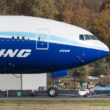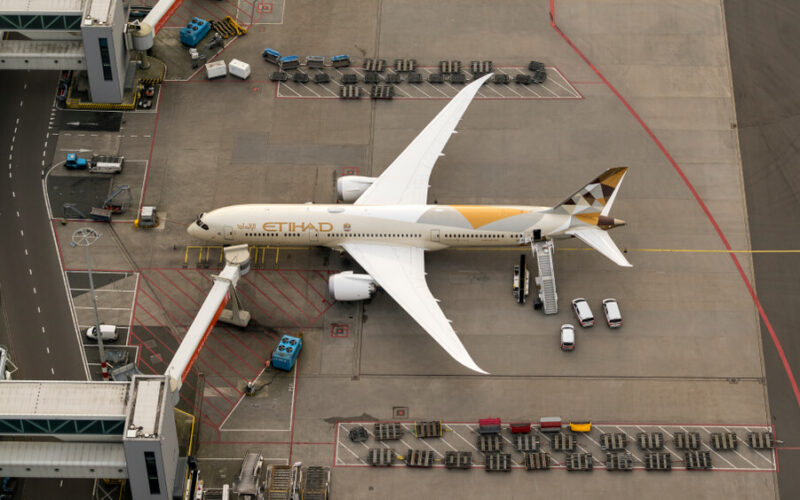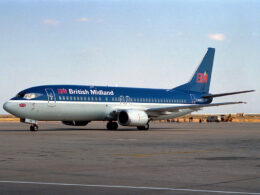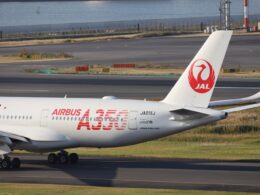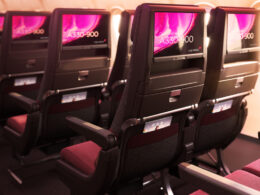On December 12, 2019, Wizz Air announced that it plans to establish its first subsidiary outside of Europe, Wizz Air Abu Dhabi. Two months prior, Abu Dhabi’s flag carrier Etihad, partnered together with Air Arabia, announced Air Arabia Abu Dhabi – a low-cost joint venture (JV) based in the same city and airport as Wizz’s new subsidiary. The two sides are set for a showdown in 2020, as both companies plan to launch their respective subsidiaries during the year.
The pair chose an interesting market. After all, the Middle East region is not famous for its low-cost brand names, unlike in other continents. Gulf airlines are known for their over the top luxury, including private suits on their aircraft, with a majority of the world‘s Airbus A380s operating in the region.
The same trend is reflected in market share. Only Flydubai has a strong market presence, ranking number five in terms of capacity in the Middle East, according to data by CAPA. However, low-cost carriers (LCCs) grew leaps and bounds ahead of the legacy carriers. In 2019, the LCCS increased capacity by 12.2%, while full-service airlines grew by 3.3%, which indicates a change in consumer practices within the region.
So why has Abu Dhabi suddenly became such a lucrative market for new low-cost ventures?
Economic Emirates‘ goals
There is no secret that stereotypically the United Arab Emirates is known for its oil and gas industry. And for a good reason, as the aforementioned industry generates almost 30% of UAE’s Gross Domestic Product (GDP), making it a crucial sector for the wellbeing of the country. One of the main goals of the local government is to diversify its income, as it aims to grow the portion of non-oil real GDP growth.
“The Government is focusing on the UAE becoming the economic, touristic and commercial capital for more than two billion people,” states the government’s website regarding its Vision 2021 program.
Furthermore, Abu Dhabi itself wants to become an “attractive, distinct tourism destination.” To achieve that goal, the Department of Culture and Tourism of Abu Dhabi launched a five-year strategic plan in 2016, with the goal to contribute 4% to the Emirates’ GDP. The Department, amongst other things, aims to achieve this by “boosting visitor numbers […]” and “stimulating market demand,” as indicated in the strategy.
Evidently, the local government aims to stimulate demand by targeting a large range of travelers. This includes price-sensitive consumers from regions that typically would not travel to Abu Dhabi, as connections on local full-service carriers like Etihad or Emirates can be very costly when compared to no-frills airlines.
Wizz Air is not alone on its Abu Dhabi venture – a local company, called Abu Dhabi Developmental Holding Company (ADDHC) is holding its hand on the journey. Reports by Reuters indicate that the Budapest-based carrier will own 49% of the new airline, while ADDHC will take the remaining 51% stake. The announcement by the airline describes the Emirati company as following:
“With a clearly defined mandate to generate sustainable financial returns for the Government of Abu Dhabi, ADDH stimulates value creation by developing prominent cluster ecosystems and instilling a culture of performance and efficiency across its portfolio of companies.”
Thus, the local government is clearly involved with the two new ventures, as it also owns Etihad, the other contributing party to Air Arabia Abu Dhabi.
While it might seem counter-intuitive to essentially sponsor two new carriers to be based in Abu Dhabi International Airport (AUH), both Air Arabia and Wizz Air will bring something different to the capital of UAE.
Different markets
Over the course of the years, Etihad dipped its toes into some murky waters, investing in many airlines that later went bust. Most prominent names out of these failed investments are airberlin and Jet Airways that went bankrupt in 2017 and 2019, respectively.
On the bright side, Etihad obtained around 100 slots in Indian airports formerly owned by the Jet, as reported by Bloomberg. While increasing capacity on its own would be a risky business decision, considering the price-sensitive Indian market, the carrier’s business model and mountainous losses, a joint venture is a way to split the risk and avoid severe impact to Etihad’s already fragile financial situation.
India remains a crucial market for the UAE. Indian expats make up 27.4% of the total population in the Emirates and competition is only getting tenser, as low-cost carriers from the other side of the Indian Ocean only grow bigger. For example, IndiGo expects to increase its capacity (measured in Available Seat Kilometers, ASKs) by 25% in FY2020 compared to FY2019. Its international passenger traffic share has also increased – from 6.2% of total international passenger traffic in India in Q2 2018 to 9.6% in Q2 2019, India’s Directorate General of Civil Aviation (DGCA) data shows.
At the same time, Abu Dhabi remains a secondary-market for IndiGo. In the next seven days, daily flights to only four different cities are scheduled to take off from AUH, while IndiGo passengers are able to reach 10 different destinations in India from Dubai International Airport (DXB), shows flightradar24.com route data. SpiceJet, another Indian low-cost carrier, also has 10 different destinations from DXB, yet none from AUH. Finally, Go Air serves only three Indian cities from Abu Dhabi.
While DXB is filled with low-cost carriers, including UAE’s own Flydubai, Abu Dhabi International Airport is underserved by no-frills airlines, including the ever-growing Indian market.
The Air Arabia-Etihad partnership is cautious regarding its future plans. On November 6, 2019, Air Arabia issued a statement that any future growth plans will be announced “when they are finalized and through our official channels.”Yet an educated guess could be made that India will be one of the most important markets for it. Nevertheless, with Etihad’s commercial and marketing might and Air Arabia‘s experience, the new venture should be safe and sound, at least for now. Until it needs to grow, as a rather short backlog of aircraft could become problematic.
Wizz Air‘s proposition
What will Wizz Air bring is undoubtedly a very strong brand name in Central and Eastern Europe (CEE), where the carrier is mostly based. It is one of the few low-cost carriers from Europe that fly to the United Arab Emirates. Its nearest competition is airBaltic’s only flight from Riga Airport (RIX) to Abu Dhabi International Airport (AUH). But airBaltic runs a hybrid business model, according to the carrier’s website: “airBaltic is a hybrid airline taking the best practices both from traditional network airlines and low-cost carriers.” Thus competition is rather scarce.
Yet Wizz Air is not a newcomer to the region. Currently, during the Winter season, the Hungary-registered airline has five different routes from CEE to Dubai World Central International Airport (DWC) – it started operations in DWC in 2013.
Unlike the situation with Indian and numerous other nationalities living in the UAE, CEE residents moving to the Emirates is not a common sight, according to edarabia.com data, which shows that most of Emirates’ expats are from Asian countries. Central Intelligence Agency (CIA) infographics show that the largest ethnical group in UAE is South Asian, compromising of 59.4% of the population. Thus, Wizz Air’s Abu Dhabi venture will most likely bring tourists and business people to the region, rather than those who are visiting their relatives. This is something that aligns with the local government’s goals – to “sustain domestic and international average length of stay targets of 2.3 and 3.3 days, respectively.”
In contrast to Air Arabia Abu Dhabi that has ordered new aircraft during Dubai Airshow in November 2019 with planned deliveries starting in 2024, Wizz Air has a long backlog of Airbus jets. When the European low-cost carrier took delivery of its first A321neo in March 2019, it was the first airplane from a 184 aircraft order, which does not include further 20 A321XLR aircraft signed for at the Paris Air Show 2019.
Air Arabia has only taken delivery of three aircraft in 2019. Wizz Air, on the other hand, received 14 aircraft in 2019, Airbus’ order book shows (as of November 30, 2019). Furthermore, planespotters.net data reveals that Air Arabia group as a whole, including two subsidiaries in Egypt and Jordan, has 55 aircraft. Meanwhile, the European hero of the story operates a fleet of 119 aircraft (as of November 13, 2019).
While Etihad has 26 Airbus A321neo on order from 2013, deliveries of which were initially supposed to start in 2018, stated a press release by CFM International, the chosen supplier of engines for Etihad’s A321neos. The deteriorating financial situation of the airline has put them on hold. In its 2018 financial report, the Abu Dhabi-based carrier highlighted that after negotiating with Airbus and Boeing, Etihad has revised its “forward fleet commitments.”
While an order of 10 A320neo aircraft did not survive the chopping block, the A321neo order was kept intact. However, it remains unclear when the aircraft will reach Etihad and if any of them would go to its newest fling with the low-cost business model.




